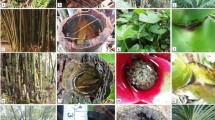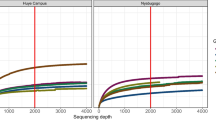Abstract
Fecal DNA samples from the red-eared slider and Reeves’ pond turtle, suspected pests of lotus root paddies, were used to identify the plant species eaten by these turtles in order to develop a strategy for rural ecosystem conservation. The fecal samples were obtained from young and adult individuals (mostly female) of both species living in agricultural canals surrounding lotus root paddies in Tokushima Prefecture, Japan. The samples were screened for the presence or absence of DNA from nine plant species using PCR and plant species-specific primers for the rbcL gene of chloroplast DNA. In the red-eared slider, our analysis identified seven plant species in the fecal DNA samples of adults and three plant species in those of young individuals. In Reeves’ pond turtle, our analysis identified two plant species from adult fecal samples and one species from those of young individuals. Thus, adult red-eared sliders consume a greater range of plants than young red-eared sliders or Reeves’ pond turtles. Both turtle species, independently of age, consumed lotus plants and were likely to cause feeding damage to lotus roots. Considering the plant species detected in adult red-eared sliders and these plant habitats, we suggest that this adult turtle is likely to travel between the agricultural canals and the lotus root paddies. These findings will help the development of strategies for preventing damage to lotus roots by these turtles; furthermore, they indicate that fecal DNA analysis will be applicable to investigation of the feeding habits of other animal species.



Similar content being viewed by others
References
Arima S, Suzuki A, Zheng SH, Okuzono M, Nishimura I (2008a) Investigation on the bite damages of young lotus by the exotic tortoise (Trachemys scripta elegans). Coast Bioenviron 11:47–53 (in Japanese)
Arima S, Suzuki A, Zheng SH, Tanaka A, Okuzono M, Nishimura I (2008b) Investigation on the damages and extermination of the exotic tortoise (Trachemys scripta elegans). Coast Bioenviron 12:53–57 (in Japanese)
Bodie JR, Semlitsch RD (2000) Spatial and temporal use of floodplain habitats by lentic and lotic species of aquatic turtles. Oecologia 122:138–146
Cadi A, Joly P (2003) Competition for basking places between the endangered European pond turtle (Emys orbicularis galloitalica) and the introduced red-eared slider (Trachemys scripta elegans). Can J Zool 81:1392–1398
Cadi A, Joly P (2004) Impact of the introduction of the red-eared slider (Trachemys scripta elegans) on survival rates of the European pond turtle (Emys orbicularis). Biodivers Conserv 13:2511–2518
Cadi A, Delmas V, Prévot-Julliard AC, Joly P, Pieau C, Girondot M (2004) Successful reproduction of the introduced slider turtle (Trachemys scripta elegans) in the South of France. Aquat Conserv 14:237–246
Clark DB, Gibbons JW (1969) Dietary shift in the turtle Pseudemys scripta (Schoepff) from youth to maturity. Copeia 1969:704–706
Ernst CH, Lovich JE (2009) Turtles of the United States and Canada. JHU Press, Maryland
Global Invasive Species Database (2016) 100 of the world’s worst invasive alien species. http://iucngisd.org/gisd/100_worst.php. Accessed 10 May 2016
Haramura T, Yamane M, Mori A (2008) Preliminary survey on the turtle community in a lotic environment of the Kizu River. Curr Herpetol 27:101–108
Haramura T, Yamane M, Mori A (2010) Radiotelemetric study of movement patterns of lotic freshwater turtles during breeding and hibernation seasons. J Freshw Ecol 25:251–259
Hart DR (1983) Dietary and habitat shift with size of red-eared turtles (Pseudemys scripta) in a southern Louisiana population. Herpetologica 39:285–290
Hidaka T, Suzuki D (2010) The introduction of the Japanese populations of Chinemys reevesii estimated by the descriptions in the pharmacopias in Edo Era. Bull Herpetol Soc Jpn 2010:41–46 (in Japanese)
Kato H, Odagiri Y, Hattori T, Honda A (2014) The current distribution and status of the red-eared turtle, Trachemys scripta elegans (Testudines, Emydidae) as invasive species in the Asabata area, Shizuoka, Japan. Nat Hist Tokay Dist 7:21–24 (in Japanese with English abstract)
Koizumi N, Mori A, Mineta T, Sawada E, Watabe K, Takemura T (2016) Exploratory environmental DNA analysis for investigating plant-feeding habit of the red-eared turtle using their feces samples. J Teknol 78:9–13
Lee HJ, Park DS (2010) Distribution, habitat characteristics, and diet of freshwater turtles in the surrounding area of the Seomjin River and Nam River in southern Korea. J Ecol Field Biol 33:237–244
Lovich JE, Yasukawa Y, Ota H (2011) Mauremys reevesii (Gray 1831)—Reeves’ turtle, Chinese three-keeled pond turtle. Chelonian Res Monogr 5:050.01–050.10
Matsuki R, Abe S, Takeuchi T, Nashimoto M, Shimano K (2008) Construction of a plant rbcL gene database and its application to analysis of food habits of herbivorous animals. Jpn J Ecol 58:105–112 (in Japanese)
Mine K, Taniguchi M (2015) Records of Trachemys scripta elegans feeding in the wild. Kiraku 10:19 (in Japanese)
Mine K, Taniguchi M, Ebira K, Kamezaki N (2014) Diet of Trachemys scripta elegans and Mauremys reevesii. Kiraku 8:12–15 (in Japanese)
National Institute for Environmental Studies (2016) Trachemys scripta elegans. Invasive species of Japan. https://www.nies.go.jp/biodiversity/invasive/DB/detail/30050e. Accessed 10 May 2016
Nature Conservation Society of Japan (2014) Nature research 2013, search for turtles in Japan. Rep Nat Conserv Soc Jpn 53:1–26 (in Japanese)
Noda H (2014) The change of population structure of freshwarer turtles for a decade till 2013 in Kahokugata. Kahokugata Lake Sci 17:1–6 (in Japanese)
Noda H, Kamata N (2004) Relationships between population traits and food habits in aquatic turtles. Bull Herpetol Soc Jpn 2004:102–113 (in Japanese)
Okada Y, Yabe T, Yamada T, Kobayashi H, Maezawa K, Oda S (2005) Distribution of freshwater turtles in western Mikawa area. Rep Yahagi River Inst 9:5–17 (in Japanese with English abstract)
Pearson SH, Avery HW, Spotila JR (2015) Juvenile invasive red-eared slider turtles negatively impact the growth of native turtles: implications for global freshwater turtle populations. Biol Conserv 186:115–121
Pérez-Santigosa N, Florencio M, Hidalgo-Vila J, Díaz-Paniagua C (2011) Does the exotic invader turtle, Trachemys scripta elegans, compete for food with coexisting native turtles? Amphibia-Reptilia 32:167–175
Ramsay NF, Ng PKA, O’Riordan RM, Chou LM (2007) The red-eared slider (Trachemys scripta elegans) in Asia: a review. In: Gherardi F (ed) Biological invaders in inland waters: profiles, distribution, and threats. Springer, Heidelberg, pp 161–174
Seitai Koubou (2012) A way of control of the red-eared slider turtle. Seitai Koubou, Tokyo (in Japanese)
Shaw JL, Clarke LJ, Wedderburn SD, Barnes TC, Weyrich LS, Cooper A (2016) Comparison of environmental DNA metabarcoding and conventional fish survey methods in a river system. Biol Conserv 197:131–138
Shirako T, Aichi M, Ueno K, Minami M (2014) Identification of plant residual substances in the feces of Apodemus speciosus and A. argenteus by chloroplast rbcL gene sequences. Honyurui Kagaku 54:95–101 (in Japanese with English abstract)
Shirako T, Ishizawa Y, Ajioka Y, Aichi M, Ueno K, Hoa DT, Hai BT, Thanh TV, Yamada M, Minami M (2015) Identification of Muridae species and their food resources using DNA barcoding in Cat Tien National Park, Vietnam. Mamm Study 40:217–229
Staats M, Arulandhu AJ, Gravendeel B, Holst-Jensen A, Scholtens I, Peelen T, Prins TW, Kok E (2016) Advances in DNA metabarcoding for food and wildlife forensic species identification. Anal Bioanal Chem 408:4615–4630
Sugiura S, Taguchi T (2012) Estimating the feeding habits of largemouth bass and bluegill around Noda Lake, a satellite lake of Lake Biwa, based on stomach contents and fecal DNA. Nippon Suisan Gakk 78:43–53 (in Japanese with English abstract)
Suzuki D, Ota H, Oh HS, Hikida T (2011) Origin of Japanese populations of Reeves’ pond turtle, Mauremys reevesii (Reptilia: Geoemydidae), as inferred by a molecular approach. Chelonian Conserv Biol 10:237–249
Tempaku M, Osawa S, Katsuno T (2009) Relationships between the faunistic composition of freshwater turtles and the habitat in Miura Peninsula. J Jpn Inst Landsc Archit 72:547–552 (in Japanese with English abstract)
Ueno S, Sasai T, Ishihara T, Taniguchi M, Mine K, Kamezaki N (2014) Food habits of freshwater turtles and sea turtles in Japan. Bull Herpetol Soc Jpn 2014:146–158 (in Japanese)
Washington Nature Mapping Program (2016) Animal facts: red-eared slider. http://naturemappingfoundation.org/natmap/facts/red-eared_slider_712.html. Accessed 10 November 2016
Yabe T (2007) Increase of alien turtles in the pond at Kawahara Shrine, Nagoya, in Central Japan, and the role of the local community in its countermeasures. Stud Community Policy 9:21–39 (in Japanese with English abstract)
Acknowledgements
This study was supported in part by JSPS KAKENHI Grant Nos. 26450348, 16K07951 and 25450367. The authors thank Dr. Lisa Monna and Ms. Aiko Suzuki for their support in DNA analysis, to Dr. Masaru Yamaoka for his understanding of this study and to Mr. Philip Johnson and Editage (www.editage.jp) for their English language editing.
Author information
Authors and Affiliations
Corresponding author
Rights and permissions
About this article
Cite this article
Koizumi, N., Mori, A., Mineta, T. et al. Plant species identification using fecal DNAs from red-eared slider and Reeves’ pond turtle in agricultural canals for rural ecosystem conservation. Paddy Water Environ 15, 723–730 (2017). https://doi.org/10.1007/s10333-016-0576-5
Received:
Revised:
Accepted:
Published:
Issue Date:
DOI: https://doi.org/10.1007/s10333-016-0576-5




